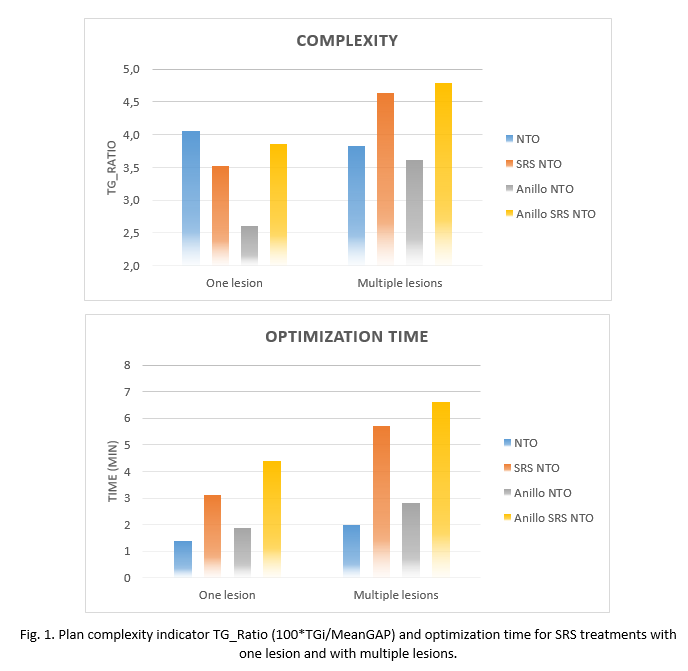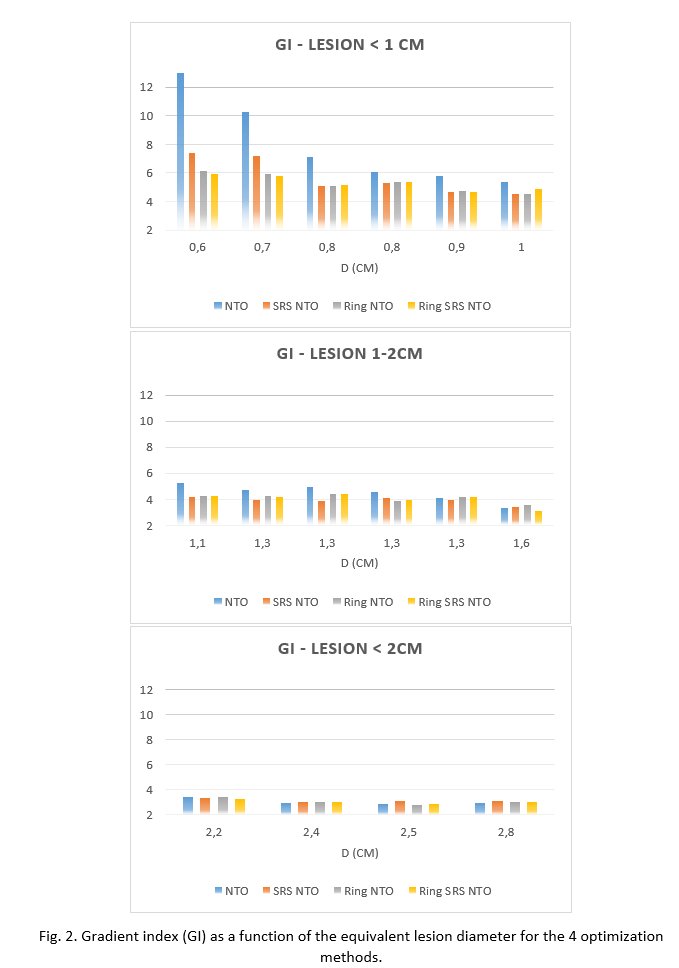Analysis of different optimization methods for single and multiple metastases SRS plans
PO-2048
Abstract
Analysis of different optimization methods for single and multiple metastases SRS plans
Authors: MARIA ROCH1, Pablo Castro1, David Hernandez1, Rocio Simon1, Pablo Chamorro1, Sergio Honorato1, Susana Gonzalo2, Maite Murillo2
1H.U. La Princesa, Medical Physicist, Madrid, Spain; 2H.U. La Princesa, Radiation Oncologist, Madrid, Spain
Show Affiliations
Hide Affiliations
Purpose or Objective
SRS plans are complex due to the combination of two factors: small target volumes (<= 1 cm) and very high dose gradient requirements to preserve healthy tissue. The objective of this work is to determine the optimization method that generates the least complex plan meeting the gradient, conformity and homogeneity objectives required for this type of treatment.
Material and Methods
9 patients are studied, 4 with one metastasis and the rest with multiple metastases [2-6], a total of 18 lesions (mean 1.5 cm [0.6-2.8]). Plans are generated with HyperArc (Varian) using 4 arcs. Eclipse v16.1 and the optimizer PO v16.1 are used to calculate the plans. Different optimization options are analyzed:
(a) NTO (priority 100). Lower volume objective 95-100% of prescription dose and upper 120%.
(b) SRS NTO (priority 100): same as NTO but with SRS NTO.
(c) RING + NTO. Optimization objectives according to [1] using auxiliary ring structures around the target volumes and NTO option selected with priority 100.
(d) RING + SRS NTO. Same as RING + NTO but with SRS NTO.
The plans are normalized if necessary to ensure that 95% of the target volume is covered by the prescription dose.
The following data are obtained from each calculated plan:
- Complexity: optimization time and MLC parameters, concerning the average segment (MeanGAP) and the relevance of the Tongue & Groove effect in the plan (TGi) with the in house program PlanAnalyser provided by V. Hernandez [2].
- Gradient: gradient index (GI).
- Conformation: RTOG conformation index (CI).
- Homogeneity: homogeneity index ICRU83 and Dmax.
For each optimization method the initial plan is the most complex and is obtained without monitor units (MU) limitation. In each iteration, lower target MUs are imposed to obtain simpler plans (higher MeanGAP and lower TGi).
[1] Desai DD, et al. DOI: 10.1002/acm2.13254
[2] Victor Hernandez, et al. DOI: 10.1016/j.phro.2018.02.002
Results
To analyze plan complexity, a distinction is made between single and multiple metastases treatments. For both cases the plans produced including the SRS NTO option are more complex and require longer optimization time. The Ring + NTO optimization method generates the least complex plans with reduced optimization time (Fig. 1).

To analyze plan quality metrics, lesions are grouped into 3 sizes (<1cm, 1-2cm and >2cm). GI only reaches values of 3 - 4 for 1-2 cm lesions or larger. The Ring optimization method (NTO or SRS NTO) provides the smallest gradient values (Fig. 2). The four optimization methods give similar CI values, for lesions < 1cm in size the CI values > 1.2. Regarding to homogeneity, for small lesions there is no difference between the optimization methods. However, for lesions 1-2cm or larger, more homogeneous plans are obtained with the optimization by the Ring method.

Conclusion
Optimization with the NTO Ring method generates less complex plans, with a better gradient index and, for not very small lesions, with good homogeneity, using reduced optimizer times.